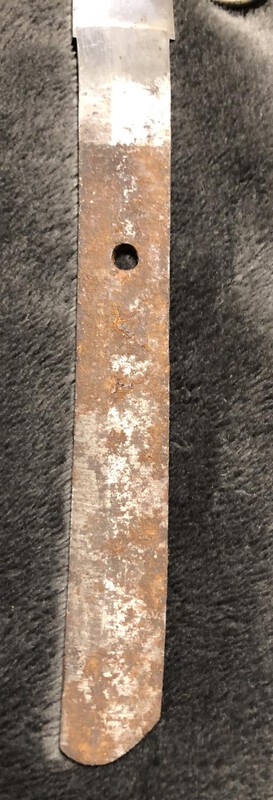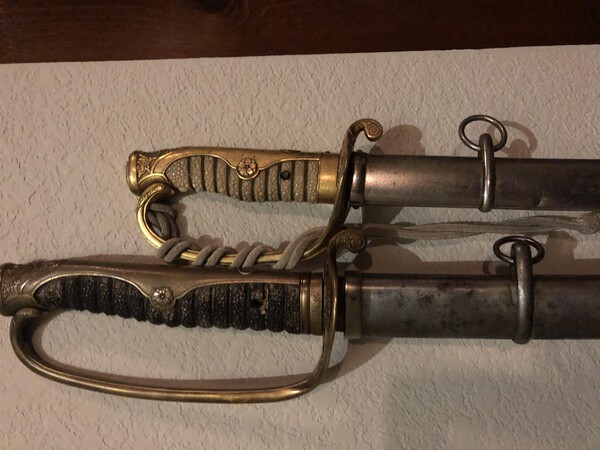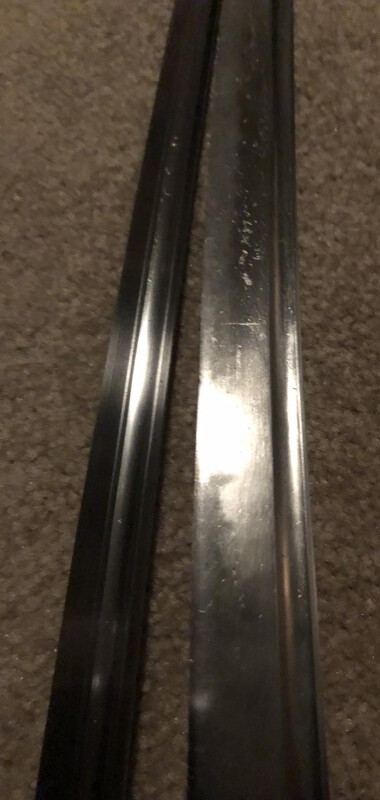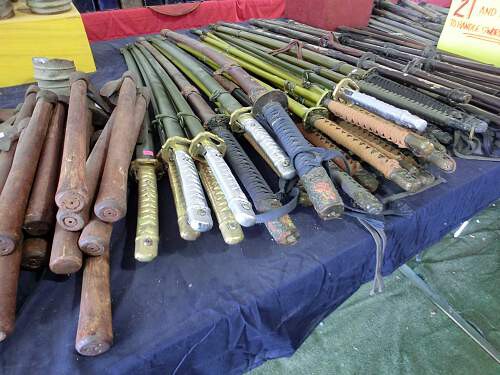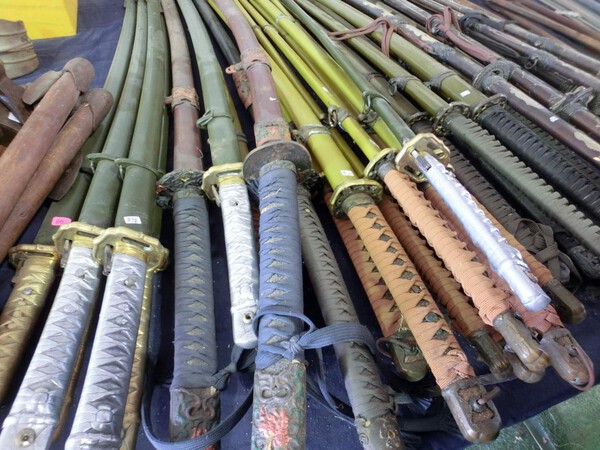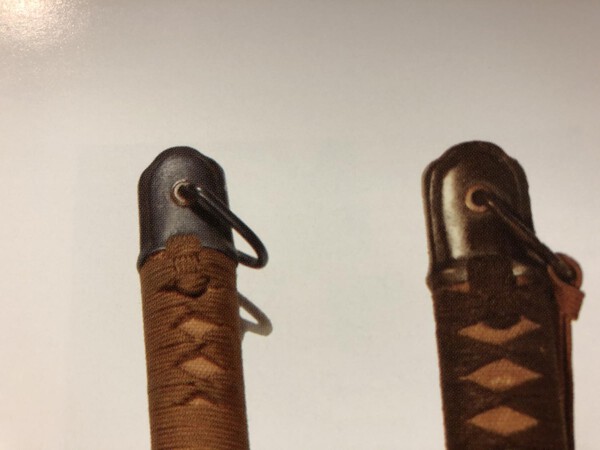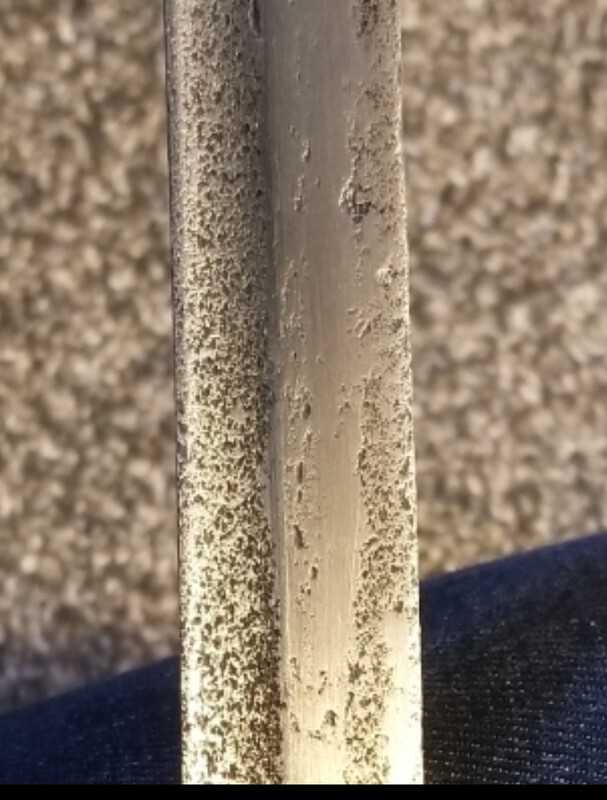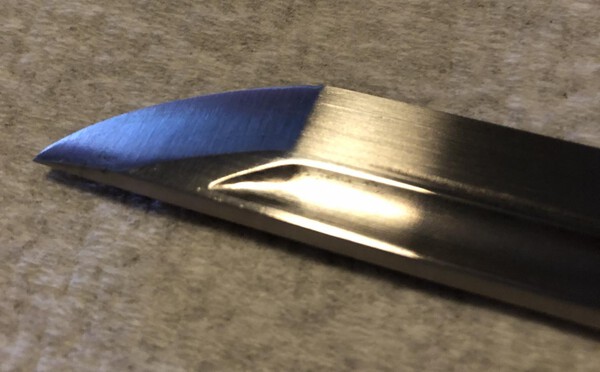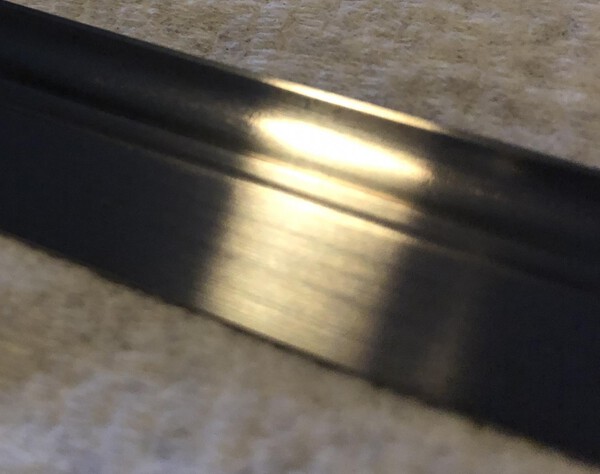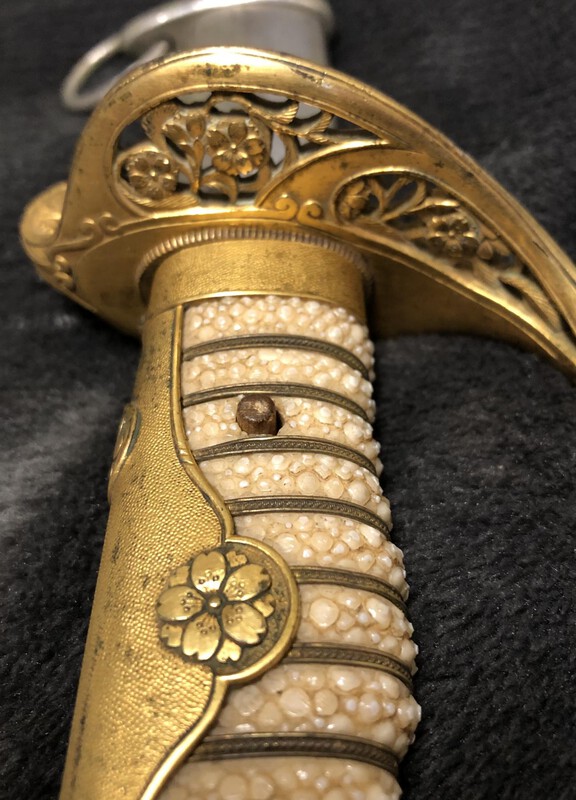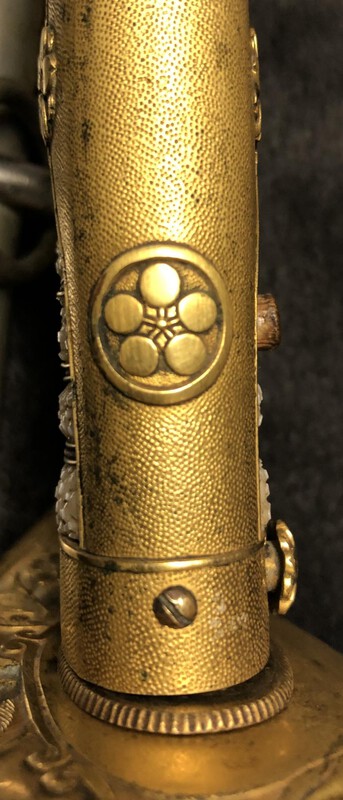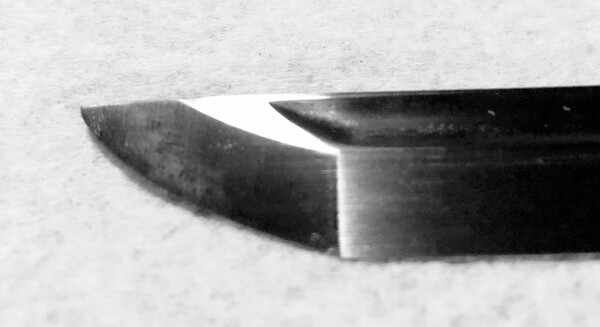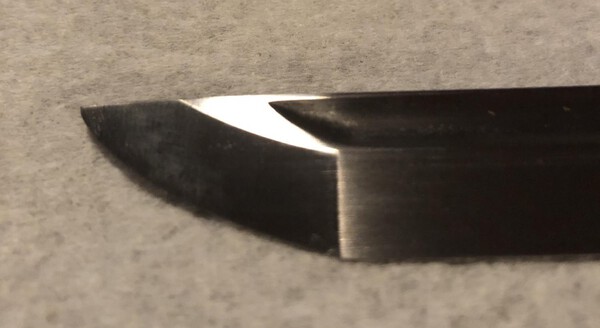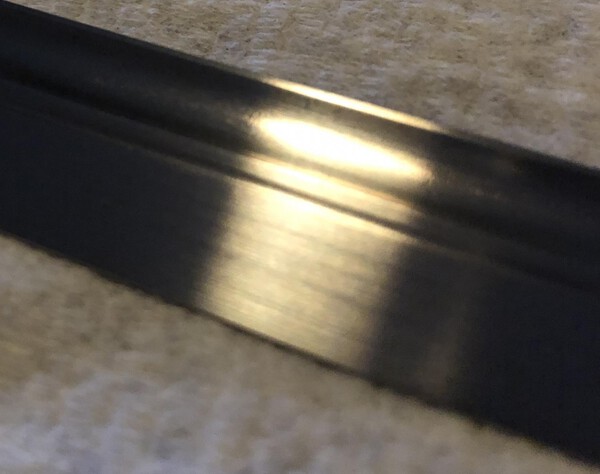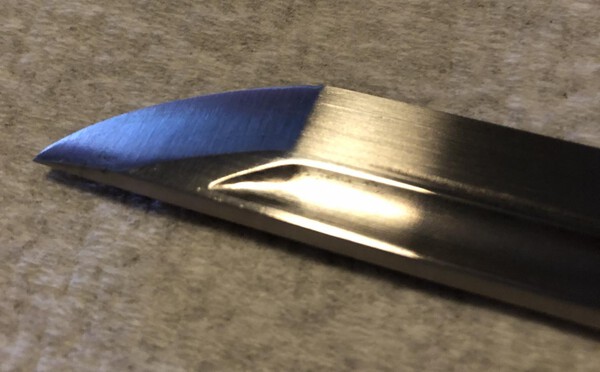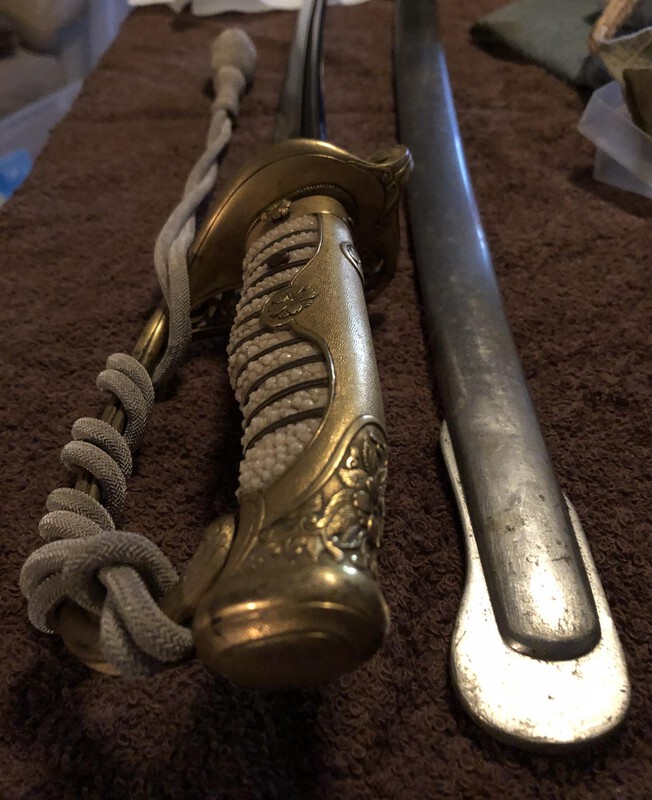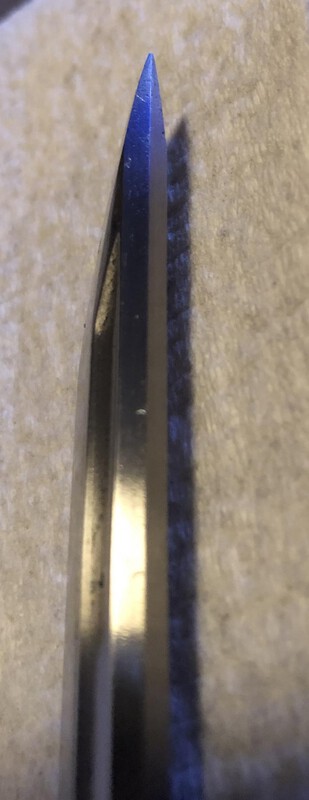-
Posts
13,018 -
Joined
-
Last visited
-
Days Won
155
Content Type
Profiles
Forums
Events
Store
Downloads
Gallery
Everything posted by Bruce Pennington
-
John,I don't think it is. There is orange active rust, but doesn't seem to have any of the dark old stuff, so likely in that 40 yr window when they were making these.
-

High Quality Gunto Field Repair
Bruce Pennington replied to Bruce Pennington's topic in Military Swords of Japan
Rather than start a new thread, I thought this one would work to continue a discussion of items that might be examples of field repair. I now have 2 gunto - one a Type 95, and the other a kyugunto - with large brass/copper "after-market" fittings. I got the Type 95 first, and assumed it was a Bubba-fix to a loose tsuka. But after seeing this habaki extension created for this kyu, I'm starting to wonder. Both the 95 and the kyu were missing seppa, and it appears these "fixes" were made to tighten the tsuka of them both. From the 95 - I removed the fat seppa and replaced it with correct ones. I don't have original pics of how it looked on the blades: The kyu. It's missing the chuso as well as seppa. And the width of the habki addition is too wide to fit into the saya opening: I suppose it's quite possible they were both post-war made by crafty buys to tighten the tsuka. But I wonder if they could have been field repairs. Thoughts? Any more examples out there? -
As a newbie to the Kyu, I thought it would be nice to have a thread where Kyu collectors could compare notes, ask questions, and show their stuff. I got one at auction, that I intend to sell, but I was surprised at it's size. My first one is single-handed, but still a D-ring. This second one is a beast! Double-handed in the tsuka and the blade is twice the width of my first one! I didn't realize there was such variation in sizes.
-
This is at a gem show in Tucson AZ : http://www.warrelics.eu/forum/Japanese-militaria/piles-fake-swords-758091/
-
That's actually quite low for the Japanese sites.
-
You continue to amaze, Thomas! Where do you find this stuff?
-
Fascinating bit of history at Warrelics about terms from Nick Komiya, responding to Thomas' digging up army kanji for "saya": https://www.amazon.com/Japanese-Military-Civil-Swords-Dirks/dp/1574270621 "There is actually a small story of its own attached to the evolution of the Japanese language used by the army. In a nutshell, senior officers of the early IJA were ex-samurai, mainly from the southern island of Kyushu, and for the Samurai, learning classical Chinese was obligatory as Latin was for European intellectuals of the time. On the other hand, the ex-farmers that got inducted into the new army, though extremely literate by international standards of those times (In the Kyushu region, roughly 70% of the general population was literate). However, between those educated in classical Chinese and those with normal daily farm-hand literacy, there was naturally a world of disparity in Kanji literacy. Thus by 1940, there were too many complicated weapon names that simple soldiers could no longer keep up with. So the army finally decided to simplify its naming practices. They did this by restricting the weapons vocabulary to a maximum of 1,235 Kanji. Of this number, 959 were classified as class 1 kanji, obligatory for the most basic weapon ("A class weapons" 甲兵器 ) names. The Class 1 range was picked from Kanji you should know by the end of the 4th year in elementary school with a sprinkling of some simple 5th and 6th-grader kanji. There were further 276 Class 2 Kanjis taken from elementary school graduate level and applied to weapons used by higher qualified personnel ("B class weapons"乙兵器). Regarding the naming of the scabbard for the Type 95 sword as 革+室 as seen in the 1938 document. It may very likely be an army invented kanji (Ate-ji). Back in 1887, the army called the leather sheaths for field engineer tools Kaku-Shitsu, written 革室, literally meaning “leather chamber”. This word was used for 20 years until they changed the naming of the case to a bag, Fukuro 袋 in 1907. Arisaka of rifle design fame had a role in coining unique army naming practices that defied conventional kanji readings and he happened to be he chief of army weapons development, a position with enough clout to screw up army lingo beyond recognition to educated laymen. See here for details on that story. These two kanji seem to have been joined together later at the hip to mean Saya for the NCO swords. Thus 革+室 was already in use from the Type 32 swords. Officer swords on the other hand, had been using the more traditional Kanji for Saya 鞘 at least since the 1912 model officer swords. This difference in the kanji used for scabbard got carried over into the Type 94, 95 and 98 swords. Thus until weapon name kanji restrictions came into effect in Feb. 1940, officer and NCO swords did not share the same kanji for what would have been read Saya, whichever way you wrote it. The 1940 army lingo simplification worked also as a social equalizer in this respect, as both Kanji got dropped from the permissible kanji list. Saya 鞘 for officer swords continued to be used, but it became mandatory to add Furigana, showing how to read it. In the case of Type 95 swords, they simply ceased to use the army-coined kanji for Saya and switched to Hiragana, as seen in the manual shown from 1944 in post 14."
-
Or rather as gimei.
-

A Pretty Crude Late War Gunto.
Bruce Pennington replied to MacTheWhopper's topic in Military Swords of Japan
Well they got the blade tip down pretty close! Usually they get the tip wrong. I don’t see anything else, though that looks Japanese. -

A Pretty Crude Late War Gunto.
Bruce Pennington replied to MacTheWhopper's topic in Military Swords of Japan
Kenny, My tendency with these, and we've seen a few lately, same style, is to lean toward - Chinese fake. I've never seen a "late war" officer or NCO gunto as crudely make as these. Can you post a clear picture of the blade tip? The only legit late-war 98's I've seen come with the style I'm posting a pic of. I could be wrong. -

Don't Try this at Home! (when spouse is around :)
Bruce Pennington replied to zook's topic in Military Swords of Japan
Sheesh Dan! My wife has even proposed I sell all my gunto to pay for the motorcycle I need to buy!!! What was she thinking?!?! To answer your question - if you claim the knee mortar is just a saya for a really short, fat tanto, then it can stay! -
The mei is good enough on all 4 of our Possible Fakes, that if there were no other reason to suspect them, they would be considered legit. In fact, they are so good, and the serial numbers are using the correct kanji for the year-group, that I cannot 100% classify them as fake. But they are "under suspicion." JP, actually both of the Komonjo blades I have photos of, have the same polisher's marking:
-

Japanese Calvary and Artillery Sword
Bruce Pennington replied to waljamada's topic in Military Swords of Japan
I'm going to chime in on this, for what it's worth. I truly respect what you guys are doing by discouraging DIY polishing, and understand why it's a really bad idea. But have you guys clicked on any of his pics and enlarged them? If this blade were a nihonto, you'd be saying "Total write-off. This blade is worthless." and I have heard it said by many on these forums. If I had the search skills of Thomas, I'd pull them up and quote each of you on that. And this blade is worse off than any of them. So if a blade is "ruined" and is not worth resoration (in other words - trash) honestly - what difference does it make if a guy tries to remove some of the destruction? I personally think he is honoring this blade by his efforts to try to give it a little dignity back. Yes, if another rookie sees what he is doing, would he naively be encouraged to do the same thing to his newly acquired rusty nihonto? Possilby. But you've clearly discussed why that isn't good to do, so unlikely. I wouldn't do metal-work on any of my 95s or 32s to remove rust spots, but they are good blades. Adam's is truly a "gonner". I don't see his work as anything but an effort to save what he can of a destroyed blade. Please click on this pic: -
Sure, most buyers would never know it's a fake. They'd be exceptionally happy to receive this gunto. The discrepancies are subtle. The file marks are sloppy and thinly applied. I compared a Mu 89, which would only be 2 blades apart from this one, and it's marks are precise and more deeply cut. That alone wouldn't put me off, but a heavier mark against this one is the mei. I have 42 1942's on file and they are ALL Koa Isshin mei. This mei, 満鉄鍛造之, doesn't appear on Mantetsu blades until 1943. I'll admit, one should never say never, nor always! BUT, this blade would be a first if legit. Add to this, like Thomas said, there have been 3 other "probable" fakes appear recently (Komonjo sales) that have the same polisher marks and have dedications added to the mei. So it fits the pattern of a particular Japanese faker that is periodically putting these out.
-
Nice work JP, and all from memory!!! I'll hold my comments until we get all the input we can.
-
There have been some recent discussion of WWII showato being sold on the civil market. It's possible this blade was originally sold that way, and later coverted to military mounts, requiring a new hole to fit the standard army tsuka.
-
Thought it would be enjoyable to run a thread where everyone could post pics of some of their favorite gunto. Different than the "Show Us Your High Class Gunto" thread, in that "favorite" doen't mean "high class." It could be favorite because it's messy, shot-up, certain fittings, etc. I'll start by re-posting some shots of my Christmas gift Kyu. I was doing some semi-annual cleaning/oiling and fell more in love with my first kyugunto. Really got lucky with this just at the time my wife was looking for one for me!
-
Thanks Wim and Stephen! I tried this in the JP translator and came up with: "Hiroshi Nemoto Lt Gen carrying sword"
-
As to markings on the blade - these are called horimono and are not common, usually artwork. Chinese fakes quite often mark on the blade with imitation Japanese kanji or dragons.
-

My Christmas Present finally Came In!
Bruce Pennington replied to Bruce Pennington's topic in Military Swords of Japan
-
Jeremy, This is an officer's blade, and only NCO gunto were issued. Officers had to buy thier own and had quite a variety of places and ways to do that. Does yours have a stamp? Better pictures of the full nakago (tang), with the habaki off (brass collar) would help us all with your questions.
-
That's gorgeous Stephen. Nice eye-candy, thanks for sharing!!
-
I have a Muromachi era blade, mumei, that, as I have been told, was made during a time of many wars, and therefore was likely "mass-produced" to meet great demand. My Mantetsu is more beautiful and likely more battle worthy than that muromachi blade. The smiths of the muromachi era would have died of a heart attack if they had to face the numbers demanded of WWII smiths. Over a million blades produced! In a sense, the WWII mass-produced blades are kindred spirits with their muromachi brothers. The WWII smiths simply had "better" technology and more resources available to them than the muromachi smiths had. I understand the nomenclature the we now use to label/classify blades. It is useful for ease of communication. One guy can say he has a nice nihonto, and the other guy already knows what he's got without having to hear "I've got a nice Japanese sword made of tamahagane, heated with special coal, folded many times, and water quenched." The other guy can say, "hey, look at my great showato" and not have to say "Hey look at my great WWII blade made with unknown steel, not folded, and oil quenched." The terms save us time. LIke the muromachi blade (in truth all blades) we all know the value of the blade is in the craftsmanship and beauty, not the name. But then, that shoots us off into collectors' personal focus and we have another discussion all together!
-
Thomas, A google searh brings this up as a surname. There was a "loyal retainer", of the 47 Ronin, named Kanamaru: https://www.roningallery.com/oribe-yahei-kanamaru And a fighter ace with the name Kanamaru: https://en.m.wikipedia.org/wiki/List_of_World_War_II_aces_from_Japan So just a guess, but I'd bet it was the name of the owner. The blade was made by Amahide who had his own kakihan (hot stamp), so it likely wasn't tied to him specifically.


